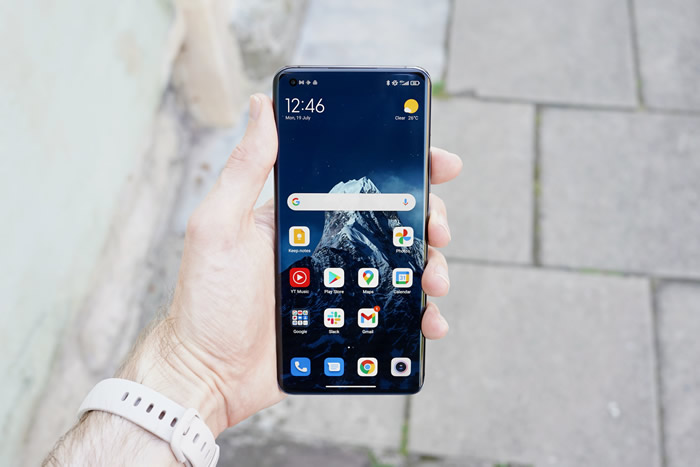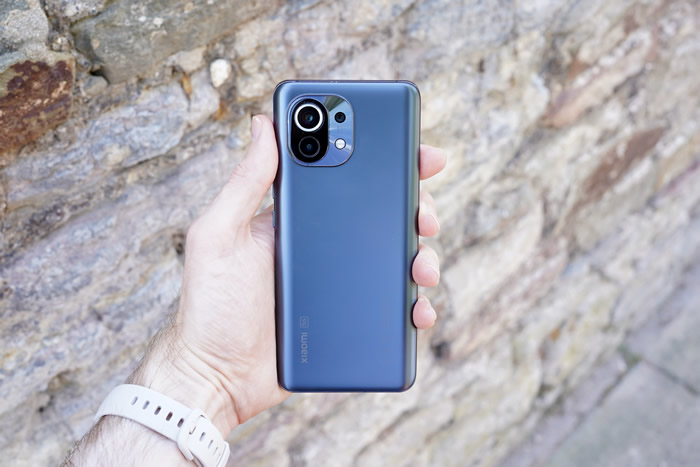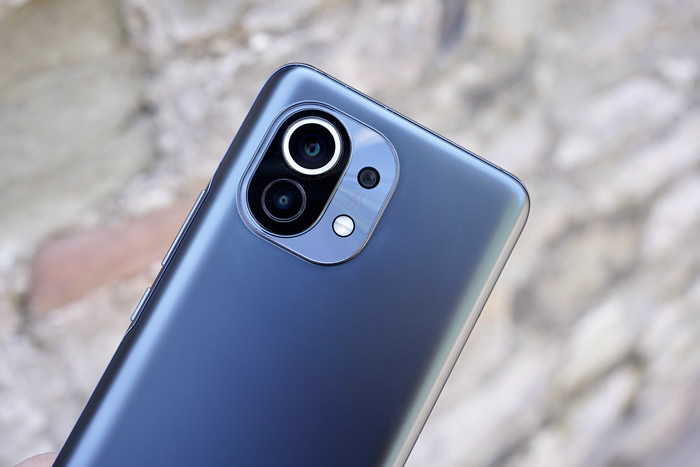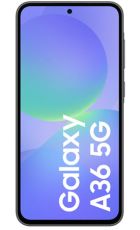Xiaomi recently overtook Apple to become the second-largest phone manufacturer in the world, and with phones like the Xiaomi Mi 11 on its roster, it’s not hard to see why.
This is an impressive 5G handset that offers a comprehensive flagship experience for significantly less money than most of its rivals.
For just £749 you’re getting top tier power and display quality, a strong main camera, fast charging, and a stylish glass-and-metal design. There have been a couple of compromises made to hit that price point, but we suspect that many people will be willing to accept them.
Screen
The Xiaomi Mi 11 goes all out with its display. This is a rich, vibrant 6.81-inch AMOLED screen with a peak brightness of 1500 nits, a 1 billion colour output, and HDR10+ support.
Like the OnePlus 9 Pro, the Oppo Find X3 Pro, and the Samsung Galaxy S21 Ultra, this screen will happily hit both a QHD (3200 x 1440) resolution and a 120Hz refresh rate simultaneously.
In a nutshell, the Xiaomi Mi 11’s display is as big, bright, sharp, and vibrant as those of phones worth hundreds of pounds more. It’s right up there with the best, which is impressive stuff.
What’s more, with a 480Hz touch input rate, it’s potentially even more responsive than those aforementioned rivals. This will only really come into play if you’re seriously into your high-end competitive games, but it’s a nice spec to have all the same.
Xiaomi also puts its AI expertise to good use in upscaling video content to look great on its display.
Design

For £749, you might have expected sacrifices when it comes to the design. But the Xiaomi Mi 11 is a slick, beautiful piece of kit.
It wears its huge display lightly, with a reasonably proportioned (though still hardly small) 164.3 x 74.6mm footprint. Its chassis is quite thin at 8.1mm, and it’s just the right side of heavy at 196g.
Xiaomi has resisted the urge to flatten the Mi 11’s display out, like OnePlus did with the (slightly cheaper) OnePlus 9. Indeed, it curves away at the top and bottom as well as the sides. This isn’t ideal for watching landscape video content, and it does lead to the odd false palm press, but it looks very classy indeed.
Nor has Xiaomi gone the OnePlus 9 or the Samsung Galaxy S21 route and switched to a plastic body - the Mi 11 has a nice polished aluminium frame, just like its pricier peers. It’s fronted by Gorilla Glass Victus, while the curvy rear is made from the slightly less advanced Gorilla Glass 5, complete with a matte finish.
All in all, the Xiaomi Mi 11 is a thoroughly modern and pleasant-to-use handset. If we were to point out one glaring design shortcoming, it would be the lack of an IP rating, so it’s not as dependably water and dust resistant as high-end rivals like the OnePlus 9 Pro.

Power
The Xiaomi Mi 11 had the honour of being the first phone to launch with Qualcomm’s Snapdragon 888 chip. This has since become the default processor for 2021 Android flagship phones.
Sure enough, the Mi 11 runs just about as smoothly as any other elite phone that’s on the market right now. Indeed, with that 120Hz refresh rate, it feels faster than the iPhone 12 Pro Max in general use, even if it doesn’t prove to be so when you get down to the benchmarks.
We’ve mentioned that the Xiaomi Mi 11 is great for games thanks to that super-responsive display, but it isn’t found wanting for graphical power either. You’ll be able to run the likes of Genshin Impact and PUBG Mobile on higher settings with a smooth frame rate.
The entry-level Mi 11 model coms with 8GB of RAM, while the top model gives you 12GB. That’s the same kind of provision you’ll find from OnePlus 9 Pro, while the Samsung Galaxy S21 5G will only supply 8GB regardless.
Camera

The Xiaomi Mi 11’s camera set-up is heavily weighted towards its main 108MP wide sensor, for better and for worse.
We should point out from the off that those shots won’t actually come out at 108MP, unless you force them to. Rather, like Samsung, Xiaomi uses pixel-binning techniques to combine multiple (four in this case) pixels into a single super-pixel, thus producing sharper 27MP shots.
At a basic level, this means that the phone is capable of taking very crisp point-and-shoot snaps, aided by Xiaomi’s strong AI scene recognition capabilities and punchy (but not fake-looking) colour science. Interestingly, the default aspect ratio for the camera is 21:9, which is far wider than usual.

The shots that result from this stretched aspect ratio are extremely cinematic, and they fill the phone’s 20:9 viewfinder beautifully. But it’s not the ideal layout for most regular shooting or sharing scenarios, and we soon reverted to the more balanced 16:9 option.
Night shots can be impressively bright and clear with the Mi 11, even in really dark conditions, though the implementation isn’t too consistent. We found that we often captured one clean blur-free shot in three. That one clean shot would look pretty good, though.

Elsewhere, the Xiaomi Mi 11’s camera provision is decidedly less impressive. The 13MP ultra-wide sensor is fairly bog standard, and certainly not up to the standard of the OnePlus 9 Pro, the OnePlus 9, or the Oppo Find X3 Pro equivalents.
Meanwhile, there’s no telephoto sensor at all here. Rather, zoomed shots need to crop in on that pixel-packed main sensor. 2x shots are just about usable thanks to the sheer number of pixels on tap, but any ‘closer’ and your shots will devolve into a noisy mess.
Instead of a telephoto lens, Xiaomi has implemented a macro sensor. It’s rather good as these things go, capable of grabbing impressive artistic close-ups. But this is quite a niche shooting scenario, and we doubt you’ll use it all that much after an initial play around.

There’s a passable 20MP selfie camera here too, which is reasonably sharp, though not so hot on skin tones.
Features
The Xiaomi Mi 11 doesn’t really have any particular features that help it stand out from the crowd. Most of the interesting features went into the Xiaomi Mi 11 Ultra, with its secondary display and huge camera sensor.
But you have to pay a steep price for those Ultra bells and whistles. The regular Mi 11 doesn’t rely on such gimmicks - it’s just a quietly accomplished flagship-level phone being offered at a really competitive price.
Indeed, when the phone does stand out from its rivals, it’s not always for the better. Xiaomi’s custom Android skin, MIUI 12.5, is far busier than rival efforts from OnePlus and Sony, and is rather less appealing overall.
It’s packed full of home-brewed apps, not all of which are particularly useful. It’s fair enough that Xiaomi should want to provide its own tools for Weather and Notes, for example, and we can even accept the value of the Themes store, which provides one of the most extensive personalisation systems on any phone.
But we really don’t need Xiaomi’s own web browser app given that the infinitely superior Google Chrome also comes pre-installed. Even less explicable is the fact that the manufacturer has also preinstalled the Opera third party web browser.
This excessively fussy tone continues with Xiaomi’s Security tool, which will launch a pointless full-screen pop up every time you install an app through the Google Play Store. You’ll also have to contend with the pre-installation of several third party apps like Tik Tok, Agoda, and WPS Office, alongside a selection of third-rate games.
MIUI has gotten a lot lighter and easier to manage in recent years, but it’s still a custom UI that would benefit from toning things down a little.
Battery life, memory and connectivity
The Xiaomi Mi 11 packs a 4600 mAh battery, which is slightly more capacious than the likes of the OnePlus 9 Pro and the Oppo Find X3 Pro (both 4500 mAh).
It doesn’t really outperform those two phones for stamina though, in our experience. In fact, it falls closer to the Sony Xperia 1 III (also 4500 mAh), in that a long day of moderate usage (around 4 hours of screen on time) will often dip you into the sub–20% danger zone. The OnePlus and Oppo phones, by contrast, will generally leave you safely in the 30% or above region.
We’re not talking about calamitously bad battery life here, but the Xiaomi Mi 11 does slightly disappoint in this area.
We’ve got no complaints about its support for 55W recharging, however. This will get you from 0 to 100% in just 45 minutes.
Yes, that’s a little slower than the OnePlus range’s bundled 65W charger. But it’s still a good deal better than the equivalent provision for the way-more-expensive Sony Xperia 1 III and Samsung Galaxy S21 Ultra - the latter of which doesn’t even give you a power brick in the box.
You also get support for 50W wireless charging, which isn’t much slower than those wired speeds. Impressive.
One note of caution here, though. We ran the GFX Bench T-Rex battery life time test on the Xiaomi Mi 11, the OnePlus 9 Pro, and the Sony Xperia 1 III side by side. Of the three, the Xiaomi scored the worst and ran worryingly hot. This, together with that middling stamina, suggests that the Mi 11’s resource management isn’t quite as well optimised or balanced as its rivals.
Storage options are pretty normal for a 2021 flagship phone, starting at 128GB with 8GB of RAM, and with a 256GB/12GB option on top of that. There’s no microSD slot, however.
The Xiaomi Mi 11 doesn’t cut any corners on the connectivity front, with full 5G support here in the UK.
Verdict
The Xiaomi Mi 11 is a solid flagship phone with one of the most aggressive price points we’ve seen in 2021. For significantly less than the OnePlus 9 Pro you’re getting a device with equivalent power and display quality, as well as a design that’s possibly even more appealing.
There are trade-offs here that you don’t have to make with the Mi 11’s more expensive rivals, though, including a somewhat inflexible camera system and a lack of IP certification. Xiaomi’s software, meanwhile, is far from the best on the market. But if you want a phone that looks and moves like a flagship for £750, the Xiaomi Mi 11 is pretty much in a class of its own.











